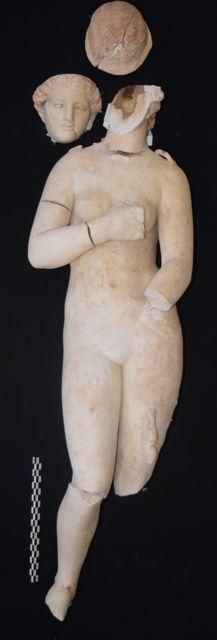'Exquisite' mythological statues discovered at the heart of Petra archaeological site
The well preserved artefact depicts the Graeco-Roman goddess of love, Aphrodite.

Statues of Graeco-Roman goddess Aphrodite have been discovered at the heart of the ancient Nabatean city of Petra, in Jordan. The find was surprising considering that the archaeologists had been digging in an area inhabited by poorer communities, who usually did not have such precious artefacts in their homes.
This is the third summer that excavations have been taking place in Petra, as part of a project known as the Petra North Ridge Project.
While archaeologists at this world-famous site have generally focused on the most extraordinary monuments – such as the tomb facades, the temples or the theatre – this initiative is intended to collect clues inside domestic structures about the ancient city's non-elite population.
Digging a luxurious villa
The team, which included students and academics from North Carolina State University and East Carolina University, had been digging what they thought was an ordinary home but quickly realised the house was bigger and more luxurious than what appeared at first. It seemed to be more like an urban villa, with its own bath house.

The marble statues were recovered close to the home's staircase. Although they are not in one piece, they remain in very good condition. They are largely intact from pedestal to shoulders, and have been called "exquisite" by Tom Parker, the dig's co-director.
"I've been doing field work in the Middle East for 45 years and never had a find of this significance," Parker noted. "These are worthy of display at the Louvre museum or the Metropolitan Museum of Art."
The statues represent Aphrodite, the mythical goddess of love, but also feature the mythological god of love, Cupid. The statues' missing heads were later recovered at the site, meaning a process of restoration will now be able to begin.
Integrating Roman culture
The experts estimate that the artefacts date back to around 106AD, when the Romans annexed Nabataea, the kingdom ruled by the Arab Nabataeans during antiquity. They are Roman in style, highlighting the cultural impact that Rome had on Nabataea.
"The Nabateans were true geniuses in many ways, in part because they were ready and willing to assimilate to and adopt elements of other cultures around them," Parker explained. "They adopted a lot of Egyptian culture when they were neighbours. When Romans took over, they were open to Roman influence."
It is not clear what the statues were doing in this part of the city and who the owners of the urban villa were. However, further excavation works have revealed more about the daily life of Petra's non-elite inhabitants.
Digging one other domestic structure and three rock-cut shaft tombs, the researchers discovered installations for cooking and storage. They found out a range of items that would have been used commonly, such as pottery and animal bones, an iron sword and ceramic oil lamp.
Finally, the discovery of human bones alongside personal objects and jewels will also allow the researchers to know more about how the ancient people living in the city viewed death and buried their dead.
© Copyright IBTimes 2025. All rights reserved.






















